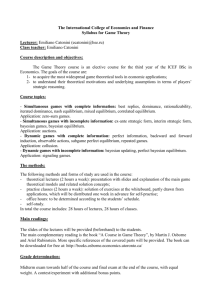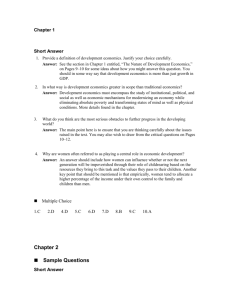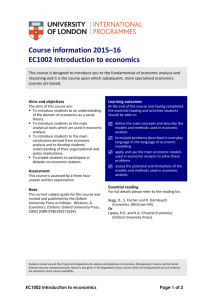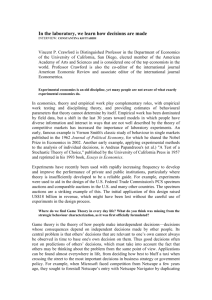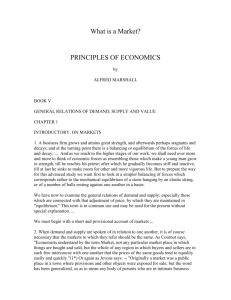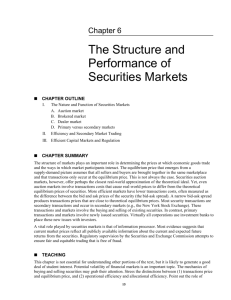Microeconomics (for Finance)
advertisement
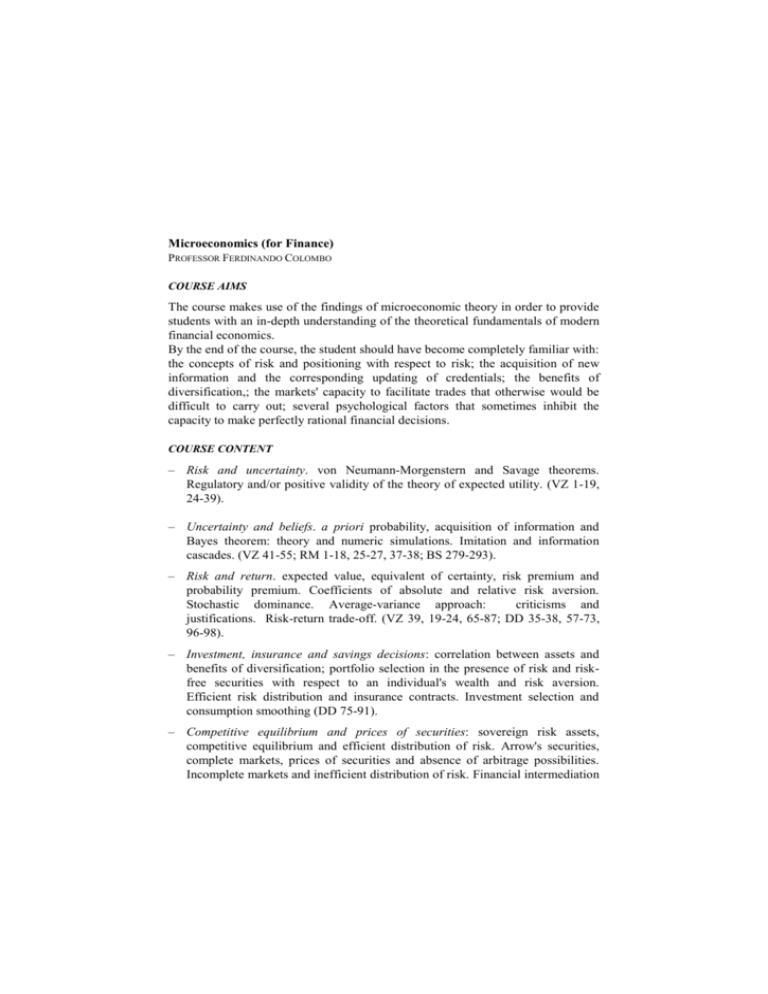
Microeconomics (for Finance) PROFESSOR FERDINANDO COLOMBO COURSE AIMS The course makes use of the findings of microeconomic theory in order to provide students with an in-depth understanding of the theoretical fundamentals of modern financial economics. By the end of the course, the student should have become completely familiar with: the concepts of risk and positioning with respect to risk; the acquisition of new information and the corresponding updating of credentials; the benefits of diversification,; the markets' capacity to facilitate trades that otherwise would be difficult to carry out; several psychological factors that sometimes inhibit the capacity to make perfectly rational financial decisions. COURSE CONTENT – Risk and uncertainty. von Neumann-Morgenstern and Savage theorems. Regulatory and/or positive validity of the theory of expected utility. (VZ 1-19, 24-39). – Uncertainty and beliefs. a priori probability, acquisition of information and Bayes theorem: theory and numeric simulations. Imitation and information cascades. (VZ 41-55; RM 1-18, 25-27, 37-38; BS 279-293). – Risk and return. expected value, equivalent of certainty, risk premium and probability premium. Coefficients of absolute and relative risk aversion. Stochastic dominance. Average-variance approach: criticisms and justifications. Risk-return trade-off. (VZ 39, 19-24, 65-87; DD 35-38, 57-73, 96-98). – Investment, insurance and savings decisions: correlation between assets and benefits of diversification; portfolio selection in the presence of risk and riskfree securities with respect to an individual's wealth and risk aversion. Efficient risk distribution and insurance contracts. Investment selection and consumption smoothing (DD 75-91). – Competitive equilibrium and prices of securities: sovereign risk assets, competitive equilibrium and efficient distribution of risk. Arrow's securities, complete markets, prices of securities and absence of arbitrage possibilities. Incomplete markets and inefficient distribution of risk. Financial intermediation and funds management: origins, growth and possible crisis of a banking system. The additive theorem of value. Options and complete markets. (DD 145-156, 195-199, 204-210; AG 58-76). – Behavioural finance: criticism of the Bayes, von Neumann-Morgenstern and Savage theorems from the positive point of view. Psychological factors that prompt investors not to update the credentials in Bayesian mode and not to make portfolio choices on the basis of preferences about their wealth. (BT 1053-1073, 1099-1104; KR 52-65; JM 17-36, 63-94). READING LIST T. VAN ZANDT, Introduction to the Economics of Uncertainty and Information, 2006. R.B. MYERSON, Probability Models for Economic Decisions, Thomson Brooks/Cole, 2005. S. BIKHCHANDANI-S. SHARMA, Herd Behavior in Financial Markets, IMF Staff Papers, 2001. J.P. DANTHINE-J.B. DONALDSON, Intermediate Financial Theory, Elsevier, Amsterdam, 2005. F. ALLEN-D. GALE, Understanding Financial Crises, Oxford University Press, Oxford, 2007. N. BARBERIS-R. THALER, A Survey of Behavioral Finance, in Constandinides et al, Handbook of the Economics of Finance, Vol. 1, Part 2, Elsevier, Amsterdam, 1052-1090, 2003. D. KAHNEMAN-M.K. RIEPE, Aspects of Investor Psychology, Journal of Portfolio Manager, 24(4), 1998. J. MONTIER, Behavioural Investing. A Practitioner’s Guide To Apply Behavioural Finance, John Wiley & Sons, 2007. TEACHING METHOD Lectures, assignments in class, and periodic homework. The following software will be used during the course: Microsoft Excel and add-in Simtools. ASSESSMENT METHOD Written, with questions about theory and numerical exercises. A IT-related exercise in the computer lab to tests the student's capacity to use Excel and Simtools for solving economic-statistical-financial problems. NOTES The course contemplates extensive use of the economic, mathematical and statistical concepts studied in the Economics I, General Math, and Statistics I courses for the threeyear degree programme. It is assumed that students enrolling in this course: are familiar with the basic rules of algebra, derivatives of polynomial and log rhythmic functions,; are able to identify the maximum and the minimum of a function of a variable; are familiar with the concepts of probability, conditioned probability, the Bayes rule, variance, covariance, coefficient of correlation; are able to interpret economically the concept of the marginal rate of substitution; and have a fairly clear idea of the concept of Walrasian equilibrium (in a framework of general economic equilibrium). Instead, familiarity with Microsoft Excel is not required, but may prove useful. Several documents will be posted on the Blackboard to facilitate preparation for the exam. Regular class attendance and active participation in the course are definitely recommended. Further information can be found on the lecturer's webpage http://www2.unicatt.it/unicattolica/docenti/index.html, or on the Faculty notice board. at




